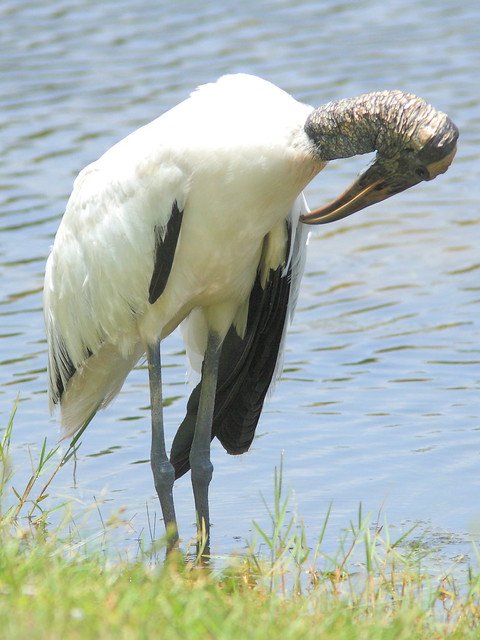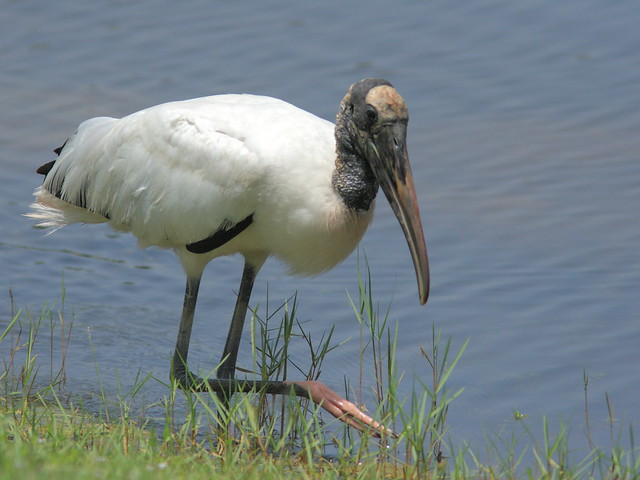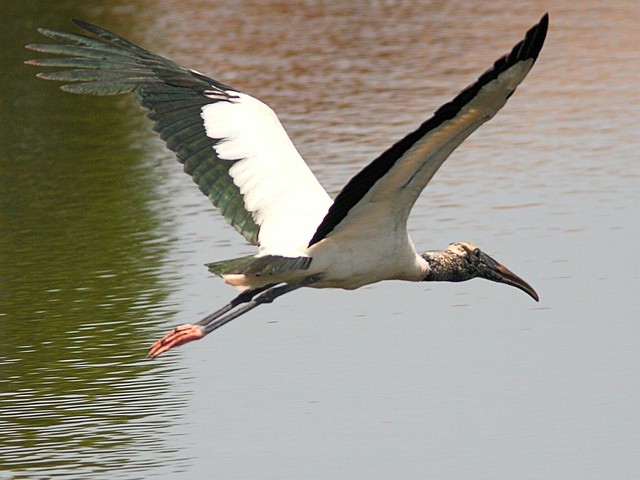This is my photo submission to the weekly Bird D’pot (Bird Digital Photography) meme hosted by Anni at I’D-Rather-B-Birdin’.
On our second morning after returning home to South Florida, this Wood Stork appeared at the edge of our back lawn. We are only seeing adults, as there has been massive nesting failure over most of southeastern Florida, most notably at Corkscrew Swamp (See my blog about Struggling Storks as well as the updated information at the bottom of this page) .
It was so close that I had trouble fitting the whole bird in the viewfinder.
It stirred the water with its bright pink feet, to startle small fishes into its bill.
Then it posed for a moment…
…before flying off across the lake.
On September 21, 2010 the US Fish & Wildlife Service published a Proposed Rule in the Federal Register to change the status of the Wood Stork from Endangered to Threatened Species, based on a petition from the Florida Homebuilders Association which desires to open up part of the stork’s Everglades habitat for housing developments. Public comments were solicited, and the comment period closed on November 22, 2010
The Audubon Society provides this evidence-based overview of the Wood Stork’s precarious status in southern Florida over the last four decades, and the importance of privately-owned wet prairies to their survival.
Although the number of Wood Stork nests outside of South Florida have increased from 1817 in the 1970s to 5491 in the 2000s, the number of nests in South Florida have not recovered, ranging from from 2406 to 2367 over the same period. Nationally the percentage of nests at Corkscrew Swamp declined from 34-37% to only 8% of the US total. There has been total nesting failure at Corkscrew since 2010.
“Audubon has conducted a wood stork foraging study which documented foraging events over the course of two nesting seasons (2006-07 and 2008-09). Data analysis revealed that wet prairies are particularly important to wood storks early in the nesting season. Mapping of foraging locations revealed that 79% of the foraging occurred on private lands in the critical early months of the nesting season. Supporting earlier nesting is critical to recovery efforts for wood stork. This suggests that conservation efforts must involve protecting the foraging values on private lands.” .
Florida Home Builders Association v. USFWS
On January 3, 2012, a 60-day notice of intent to sue was sent to USFWS on behalf of Florida Home Builders Association. Attorneys with Pacific Legal Foundation formally warned federal officials that “they will be sued if they do not immediately drop the unjustified listing of the wood stork as ‘endangered’ under the U.S. Endangered Species Act.”
In the meantime, the south Florida rookeries have continued in decline. For the past three years, Wood Storks failed to nest at all in the huge Corkscrew Swamp rookery. To date there has been no final action on the Proposed Rule. For the latest information, visit this USFWS Wood Stork web page.
UPDATE :
In the Federal Register, December 26, 2012 the U.S. Fish and Wildlife Service formally proposed regulations that will reclassify the continental United States breeding population of Wood Storks from “Endangered” to “Threatened” under the Endangered Species Act of 1973, as amended. “We find that the best available scientific and commercial data indicate that the endangered designation no longer correctly reflects the current status of the continental U.S. breeding population of the wood stork due to a substantial improvement in the species’ overall status. This proposed rule also constitutes our 12-month finding on the petition to reclassify the species.”
The content of the proposed rule contains much interesting information about the breeding biology of Wood Storks. The final rule may differ from the proposal, based upon comments and information received from the public.












